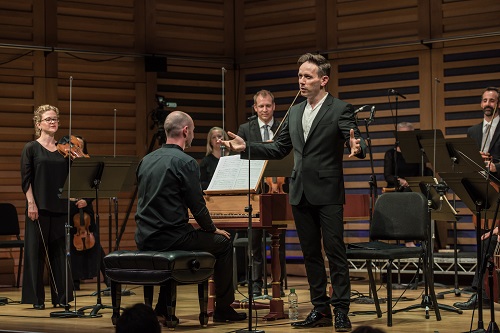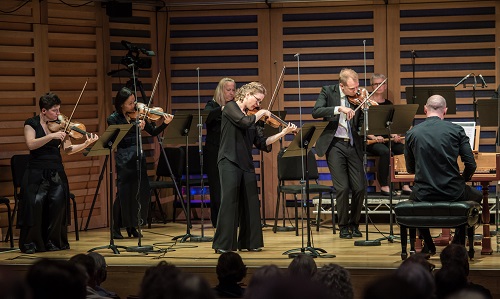At Kings Place it’s currently half-portions and double-helpings: to ‘get round’ the 50% capacity restrictions, the answer is simply to perform the concert twice – and Iestyn Davies and the members of The English Concert assembled with the countertenor on the Kings Place platform at the start of the first of the evening’s two performances certainly looked pleased to have the opportunity to do so. They sustained a relaxed informality throughout, Davies turning to follow director Peter Whelan’s score at times, fully engaged with his fellow musicians to whom he beckoned and gestured directly.
Davies’ programme was carefully named: ‘Handel’s London Altos’. As was the case with most 18th-century institutions, there was a strict set of hierarchies governing opera seria: essentially the higher the voice, the higher the singer’s rank – in terms of both the drama and the company. There was an element, too, of ‘his or hers?’ Castrato singers were assigned the lead male heroic roles, although it wasn’t uncommon for women en travesti to replace them.
When the Royal Academy opened its doors at the King’s Theatre on 2nd April 1720, these star singers, mostly from Europe, must have seemed to London audiences like rare and exotic peacocks. The year before, Handel’s attempts to lure Italian virtuosi to London had met little success; only the soprano Margherita Durastanti, who had sung Agrippina in Venice in 1709, and was highly regarded in Italy and Dresden for her performances in male roles, could be enticed – presumably by the promise of financial reward greater than that paid on the continent. But, in May 1720 Handel signed up, among others, soprano Maddalena Salvai, bass Giuseppe Boschi and two castrati Matteo Berselli and Francesco Bernardi, the latter known popularly as Senesino.
On 19th November 1720, the Academy opened its first full season with Handel’s Astarto (1720), Senesino making his London debut in the title role. And, it was at the top that he stayed, as the Academy account books confirm. With the arrival of Senesino at the Academy, Handel stopped using soprano castrati in lead male roles, assigning his leading male lovers and heroes to alto castrati, and only secondary castrati and mezzo-soprano women cross-dressed. Over the next sixteen years, Senesino created seventeen roles for Handel, including Giulio Cesare, Orlando, and Bertarido in Rodelinda. Despite their symbiotic success, the two men reportedly did not get on, and when Senesino returned to England in the 1730s he defected to the Opera of the Nobility, where he sang alongside the soprano castrato, Farinelli.

Part of Davies’ programme was devoted to some of Senesino’s ‘greatest hits’. Power and pride glow from ‘Presti omai’, the opening aria in Giulio Cesare, in which Cesare exults in his own bravery and steadfast, calling for a tribute of palms following his victory over Egypt. And, the strength and discipline that Cesare lauds, were brilliantly communicated by Davies, his vocal agility matched by the broad leaps encompassed lightly but vigorously by the oboes and strings. The registral shifts were cleanly negotiated, the tone was bright and strong, the precision as impressive as ever, and every opportunity to make a musical gesture flower was taken.
Senesimo’s most esteemed talent lay, however, in the more melting arias of deep sentiment and Davies’ also presented Cesare’s ‘Se in fiorito ameno prato’ in which his beautiful, calm melody was charmingly teased by the gentle but witty decorative darting of leader Nadja Zweiner’s violin, imitating the arrows of Cupid of which the disguised Cleopatra has just sung to win Cesare’s heart. The clarity of the rhythmic definition and the deftness of the interplay were superb, and during his graceful roulades Davies brought meaning to the text, skilfully emphasising that fair ‘Lydia’s song is so delightful that every ‘heart’ surely must be smitten, “fa ogni core/ innamorar”. Striking here, too, was the quiet strength of the Davies’ middle and lower range. At the close Zweimar modestly acknowledge the applause, not aware that her fellow musicians were beaming with pleasure at her expressive and wonderfully engaging playing.
A similar natural attentiveness to the text characterised the recitative preceding Bertarido’s ‘Dove sei’ from Rodelinda, the first plea of the aria, ‘Where are you, my beloved?’, hanging, magically suspended and then sailing forth borne on waves of longing and torment. Here, the very sweetness of Davies’ countertenor deepened the pathos of the plea for consolation, and the decoration of the da capo reprise discerningly respected the sentiment expressed through melody, enhancing the affekt.
Senesino and his fellow stars were not the first Italians to arrive in London at Handel’s instigation, however. Ten years earlier Handel had made his first attempt to introduce London audiences to the Italian opera form, and in 1711 had presented Rinaldo, the first opera written in Italian for the English stage. In the role of Goffredo, the leader of the First Crusade, was one Francesca Vanini-Boschi, a contralto and the wife of the aforementioned bass, whom Handel had encountered in 1709 in Venice when they performed the roles of Pallas and Ottone/Giunone alongside Durastanti in Agrippina, and whom he subsequently engaged for the 1710-11 London season.

And, so, Vanini’s repertoire was the focus of the remaining vocal items. We heard ‘Sorge nel petto’ from Rinaldo in which Zweiner and cellist Joseph Crouch made fine partners for Davies’ lyrical, even, yet tenderly nuanced vocal line. The short cantata ‘Splenda l’alba in oriente’ comprises a pair of arias with connecting recitative and was probably composed, in honour of St Cecilia, in 1711. The first aria was joyful and energetic with no loss of tone in the nimble passagework: when Davies sang, “Sia la lingua più canora,/ sia la cetra più sonora” (Let my voice be more melodious, let my lyre be more harmonious) it was hard to imagine how this might be achieved – and, following the long-lined fluidity of the da capo, the flamboyant closing flourish on “esalterò” (I shall always extol virtue) seemed to confirm this sentiment. The second aria in praise of virtue (as a true god of mortals) stirred the fire in the instrumental belly and the strings’ strikingly unified accents struck a perfect note of affirmation.
The anthem, ‘I will magnify thee’ was composed for the musicians of the Chapel Royal, where Handel began working in the late 1710s (it was later reused in the oratorio Belshazzar). The Chapel had its own orchestra and the ECO oboists, Katharina Spreckelsen and Sarah Humphrys, enjoyed Handel’s musical invention just as Davies relished the composer’s natural feeling for the English text.
The vocal items were linked in an almost seamless stream by varied instrumental numbers. Peter Whelan led his twelve musicians in unmannered, communicative performances – vibrant and eloquent, by turn – of the vivid Concerto from the first Act of Ottone and the Act 3 Sinfonia from Serse. From Alcina we heard the ‘Entrée des songes’; first, agréables – lilting grace; then, funestes – strong unison scales; finally, agréables effrayés – pianissimo tip-toe scurrying. The Sonata in G Op.5 No.4 was deliciously fresh; though the harmonic sequences, melodic gestures and cadential patterns may be familiar, here there was nothing formulaic about the music-making.
The encore closed the recital on a more introspective note, Penserono’s aria from L’Allegro, il Penseroso ed il Moderato, ‘Hide me from day’s garish eye’. Presenting a poignant plea for solitude, Davies’ countertenor floated serenely, the perfect embodiment of the text’s “strange mysterious dream”.
Claire Seymour
Iestyn Davies (countertenor), Peter Whelan (director), The English Concert
George Frideric Handel: Concerto from Ottone (Act I); Aria: ‘Presti omai l’Egizia terra’ from Giulio Cesare; Recitative & Aria: ‘Pompe vane di morte… Dove sei, amato bene?’ from Rodelinda; Entrée des songes agréables, Entrée des songes funestes, Entrée des songes agréables effrayés, Le combat des songes funestes et agréables from Alcina; Aria: ‘Sorge nel petto’ from Rinaldo; Sinfonia from Partenope (Act III); Aria–Recitative–Aria: ‘Splenda l’alba in oriente… Tu, armonica Cecilia… La virtute è un vero nume’, HW 166; Sonata in G, Op. 5 No. 4 (HWV 399); Sinfonia from Ariodante (Act II); Aria: ‘Se in fiorito ameno prato’ from Giulio Cesare; Sinfonia (Act III) from Serse; Aria: ‘I will magnify thee’, HWV 250b.
Kings Place, London; Thursday 24th June 2021.
ABOVE: Iestyn Davies and The English Concert at Kings Place. All images © Monika S Jakubowska/Kings Place.